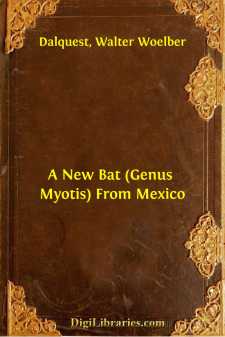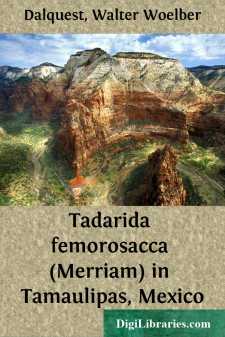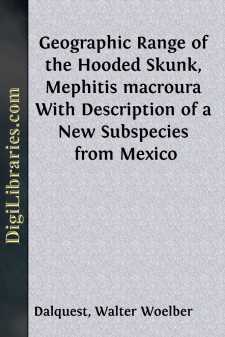Categories
- Antiques & Collectibles 13
- Architecture 36
- Art 48
- Bibles 22
- Biography & Autobiography 813
- Body, Mind & Spirit 142
- Business & Economics 28
- Children's Books 15
- Children's Fiction 12
- Computers 4
- Cooking 94
- Crafts & Hobbies 4
- Drama 346
- Education 46
- Family & Relationships 57
- Fiction 11828
- Games 19
- Gardening 17
- Health & Fitness 34
- History 1377
- House & Home 1
- Humor 147
- Juvenile Fiction 1873
- Juvenile Nonfiction 202
- Language Arts & Disciplines 88
- Law 16
- Literary Collections 686
- Literary Criticism 179
- Mathematics 13
- Medical 41
- Music 40
- Nature 179
- Non-Classifiable 1768
- Performing Arts 7
- Periodicals 1453
- Philosophy 64
- Photography 2
- Poetry 896
- Political Science 203
- Psychology 42
- Reference 154
- Religion 513
- Science 126
- Self-Help 84
- Social Science 81
- Sports & Recreation 34
- Study Aids 3
- Technology & Engineering 59
- Transportation 23
- Travel 463
- True Crime 29
A New Doglike Carnivore, Genus Cynarctus, From the Clarendonian, Pliocene, of Texas
Categories:
Description:
Excerpt
Cynarctus fortidens new species
Holotype.—Right maxilla bearing P3, P4, and M1, No. 11353 KU; bluff on west side of Turkey Creek, approximately 75 feet above stream, Raymond Farr Ranch, Center NE, NE, S. 48 Blk. C-3, E. L. and R. R. Ry. Co., Donley County, Texas [approximately 6.5 miles north and 1 mile east of Clarendon], Clarendon fauna, Early Pliocene age. Obtained by W. W. Dalquest, on June 25, 1960.
Referred material.—Fragment of right lower mandible bearing m2, No. 11354 KU (see fig. 2), found about two feet horizontally distant from the holotype in the same stratum as the holotype and on the same date by the same collector (a staff member of the Department of Biology of Midwestern University, Wichita Falls, Texas).
Fig. 1. Cynarctus fortidens, No. 11353 KU (Midwestern Univ. No. 2044).
Lateral view of holotype × 1, and occlusal view of check-teeth × 2.
Fig. 2. Cynarctus fortidens, No. 11354 KU (Midwestern Univ. No. 2045).
Lateral view of right lower mandible and m2 × 1 and oblique occlusal view of m2 × 2.
Diagnosis.—Size large (see measurements); no accessory cusp between protocone and paracone of fourth upper premolar; first upper molar longer than broad and lacking cingulum on part of tooth lingual to protocone.
Comparisons.—From Cynarctus crucidens Barbour and Cook (see page 225 of Two New Fossil Dogs of the Genus Cynarctus from Nebraska. Nebraska Geol. Surv., 4(pt. 15):223-227, 1914; also pages 330 and 338 of Dental Morphologie of the Procyonidae with a Description of Cynarctoides, Gen. Nov. Geol. Ser. Field Mus. Nat. Hist., 6:323-339, 10 figs., October 31, 1938) C. fortidens differs in lacking, instead of having, an accessory cusp between the protocone and paracone of the fourth upper premolar and in lacking, instead of having, a cingulum on the part of P4 that is internal (lingual) to the protocone.
Remarks.—The lower jaw and its second molar seem to be from an individual significantly larger than the holotype. Possibly the lower jaw and upper jaw are from two species but the lower jaw probably is from a male and the upper jaw from a female of the same species.
Reasons for regarding Cynarctus as belonging to the family Canidae instead of to the family Procyonidae have been stated recently in detail by E. C. Galbreath (Remarks on Cynarctoides acridens from the Miocene of Colorado. Trans. Kansas Acad. Sci., 59(3):373-378, 1 fig., October 31, 1956) and need not be repeated here. Although some uncertainty remains as to the familial position of Cynarctus, we favor Galbreath's view that the genus belongs in the family Canidae.
The holotype of Cynarctus crucidens is from Williams Canyon, Brown County, Nebraska. According to C. B. Schultz (in litt., December 6, 1961), Williams Canyon is a tributary of Plumb Creek; the upper part of the Valentine formation and the younger lower part of the Ash Hollow formation are exposed in Williams Canyon; which one of these formations yielded the holotype of C. crucidens is unknown.
On the basis of the correlation chart (Pl....






